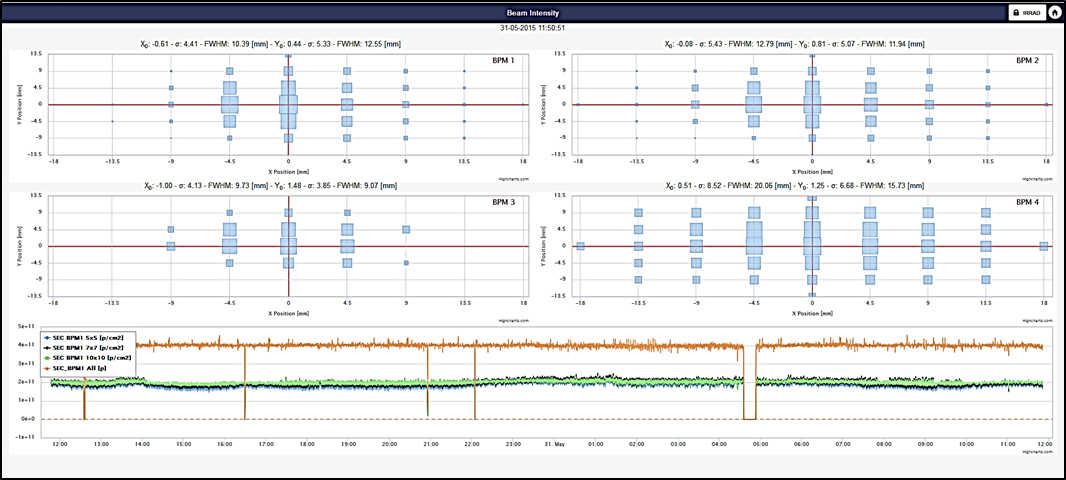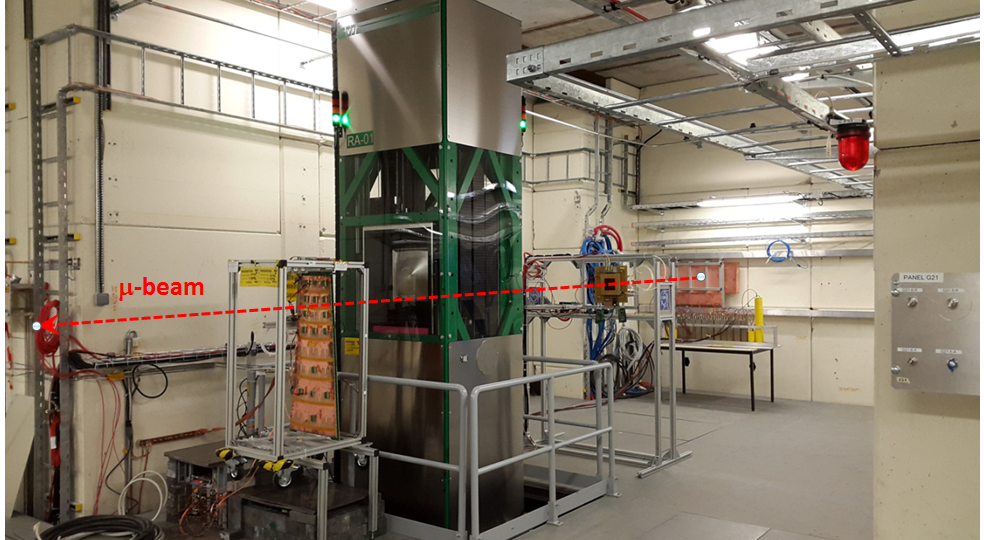The run 2015 for the PH-DT Irradiation Facilities has begun!
The PH-DT irradiation facilities team operates the Proton Irradiation Facility (IRRAD) at the PS East Area and the Gamma Irradiation Facility (GIF++) located at the SPS North Area. Moreover, the team provides support in planning irradiation experiments at CERN and organizes irradiation campaigns in facilities outside CERN upon request.
After the successful completion of the short run 2014 and a few months of shutdown for maintenance and upgrade, the new East Area Irradiation Facility is back in business since the end of April 2015.
The East Area facility is a new irradiation facility at CERN divided in two separated irradiation areas operating in parallel and sharing the same high-energy proton beam extracted from the PS accelerator on the T8 beam-line. The proton IRRAD facility (www.cern.ch/ps-irrad) is located upstream of the mixed-field CHARM facility (www.cern.ch/charm). In IRRAD, irradiation experiments are performed using the primary protons while in CHARM, a mixed-particle radiation field is used after being generated by a 50 cm thick copper or aluminium target. The new IRRAD is operated by the PH-DT group and has been designed to cope with the increasing need for irradiation experiments of the PH experimental community working for the High-Luminosity upgrade of the LHC experiments and beyond. During the 4-weeks irradiation run in 2014, more than 170 samples belonging to 16 users have been exposed to the proton beam in the IRRAD facility. The CHARM facility, operated by the EN-STI group, is optimized to reproduce the radiation environment of the LHC tunnel and the typical shielded areas of the CERN accelerator complex.
The first weeks of operation in 2015 have been spent working together with the secondary beam-line physicist and the BE-OP operator crew for the steering of the proton beam and the commissioning of several T8 optics configurations required for special irradiation runs in IRRAD and CHARM. Moreover, a dedicated run has been carried out for the calibration of the PS beam instrumentation on T8. Figure 1 shows the “standard” proton irradiation beam as seen, through the newly developed BPM multi-display, by the four Beam Profile Monitors (see PH newsletter article) installed along the IRRAD area. The pictures in the four quadrants show the beam spot tagged on a spill-by-spill basis: BPM1 (top left hand-side corner) shows the beam entering IRRAD, while BPM4 (bottom right hand-side corner) displays the transversal profile of the proton beam just before it enters the CHARM irradiation area and impinges on the mixed-field target.
Finally, in parallel with the operation, the work on the East Area facility infrastructure continues: on one end to complete the preparation of additional remote controlled irradiation systems (in order to increase the capability for parallel user experiments in IRRAD) and on the other to provide the users with a dedicated space for safe storage, handling and measurements of the irradiated samples and materials.

Fig.1 - IRRAD Beam Profile Monitor multi-display interface as part of the OP web-tools. The beam profile on the four BPM devices (four quadrants on the top) is shown together with the total proton beam intensity recorded over the last 24h (plot at the bottom of the page).
The run 2015 for the users in IRRAD and CHARM started on week 20 and will continue until the beginning of November 2015 (week 46). The detailed program, as well as all information on how to request beam-time and register samples for proton irradiation in IRRAD are available at this URL: www.cern.ch/ps-irrad. So far, more than 15 users have registered samples for the irradiation periods scheduled until summer. About the same number of users already requested also beam-time in CHARM, confirming the wide interest of the CERN experimental and accelerator communities for these new test infrastructures.

Fig.2 – A view of the GIF++ irradiation bunker. The new 137Cs irradiator (green structure) standing in the centre divides the facility in two irradiation areas: one upstream and the other downstream with respect to the H4 muon beam (dashed red line in the picture). Some user setups are visible installed on custom-built support frames in the two irradiation areas.
During the first months of 2015 another important milestone has been reached for the PH-DT irradiation facilities: the beginning of the users operation at the new Gamma Irradiation Facility (GIF++) in the North Area of the SPS.
Optimized for the characterisation and understanding of the long-term behaviour of large particle detectors, GIF++ combines a strong 14 TBq 137Cs source (about 30 times higher photon intensity compared to the old GIF facility), with high-energy charged particle beams from the secondary SPS beam line H4 in EHN1. Located near the end of H4, GIF++ exploits mainly a muon beam with momentum up to 100 GeV/c and it is scheduled to be the main user of the beam line for 3 weeks during 2015 (in July and August). In addition, the facility can receive parasitic muon beam for 30-50% of the SPS operation time, where the intensity and energy depends on the settings chosen by the primary beam line user. Gamma irradiation is however available throughout the whole year. The ~100 m2 GIF++ irradiation bunker has two independent large irradiation zones, making it possible to test real size detectors, up to several m2, as well as a broad range of smaller prototype detectors and electronic components as visible in Figure 2. A wide range of readily available gases can be used by connecting the experimental equipment to a series of gas panels distributed throughout the facility.
The installation and commissioning of the Caesium irradiator within the new bunker was carried out at the very end of 2014. The first months of the year 2015 have been spent preparing the infrastructure to host users’ equipment and to perform a detailed characterization run of the photon field in collaboration with the colleagues of the Radiation Protection group (during March 2015). Although the first irradiation experiments with the gamma source date back to April 2015, the very first period of GIF++ operation together with the parasitic particle beam just began. The number of user experiments installed in the area is growing week after week and will reach the number of 10 by the summer making already difficult to accommodate new experiments during the upcoming main-user beam time 2015. More information about the facility an on how to request irradiation and beam-time at GIF++ are available at this URL: www.cern.ch/gif-irrad.
The IRRAD and the GIF++ facilities are part of the AIDA2020 Transnational Access to irradiation facilities program which provides funding for external users to perform their irradiation tests at CERN.
The PH-DT Irradiation Team: N. Bourgeois, R. Fortin, B. Gkotse, R. Guida, M. Glaser, P. Lima, M. Moll and F. Ravotti
